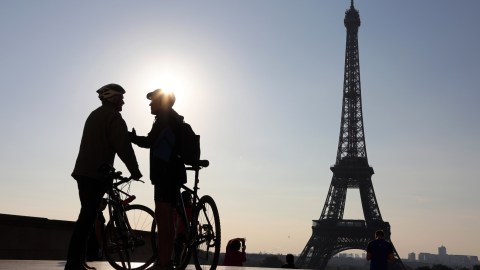The streets will never be the same: the future of car-free roads

Photo credit: LUDOVIC MARIN / Getty Staff
Major cities are giving cars the boot. By 2050, it’s estimated 66 percent of the world’s population will be living in cities. This level of urbanization will be a challenge for city planners to design sustainable infrastructures to support such a population boom. (Unless we want our cities to be like Beijing.)
“We can’t thrive if the communities where we operate don’t thrive,” says Executive VP of Corporate Responsibility at JP Morgan Chase Peter Scher.
The Norwegian capital of Oslo plans to ban all cars by 2019, doubling-down on bicycle infrastructure and public transportation. Likewise, the city of Aarhus in Denmark is taking a more passive-aggressive approach to discourage car traffic in its city by prioritizing bicycles at stoplights.
When Paris held a “day without cars” in late September, the mayor’s office reported a huge drop in air and noise pollution in the city. The Guardian reports that some parts of the city saw nitrogen dioxide levels drop by up to 40 percent — proof of the huge impact a car-less city could have on the health of its citizens.
A report done by the French Sénat found the health, economic, and financial consequences from air pollution costs France €101.3 billion ($111.4 billion) a year. In America, air pollution has been linked to the illnesses and premature deaths of tens of thousands of Americans each year.
But an analysis by researchers from the Lund University has shown that “investments in cycling infrastructure and bike-friendly policies are economically sustainable and give high returns.” The cities of the future may have to be ones without cars if we want them to be places we can live in.
“What cities are, are a sort of intricate layering of the work of many generations, one on top of another, and so, it’s subtle transformation and inflection of cities rather than whole scale transformation that’s really important,” says William J. Mitchell, one of the members of the MIT Smart Cities research group.
***
Follow Natalie on Twitter: @nat_schumaker





